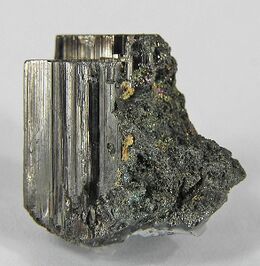Chemistry:Enargite
| Enargite | |
|---|---|
 | |
| General | |
| Category | Sulfosalt mineral |
| Formula (repeating unit) | Cu3AsS4 |
| Strunz classification | 2.KA.05 |
| Crystal system | Orthorhombic |
| Crystal class | Pyramidal (mm2) H-M symbol: (mm2) |
| Space group | Pmn21 |
| Unit cell | a = 7.407(1), b = 6.436(1) c = 6.154(1) [Å]; Z = 2 |
| Identification | |
| Color | Grayish black to iron black; gray to pale pink-brown, deep red internal reflections in polished section |
| Crystal habit | Tabular to prismatic crystals, striated parallel to {001}; massive |
| Twinning | Twin plane {320} common, rarely as interpenetrating pseudohexagonal trillings |
| Cleavage | Perfect on {110}, distinct {100} and {010} |
| Fracture | Uneven |
| Tenacity | Brittle |
| Mohs scale hardness | 3 |
| |re|er}} | Metallic to dull |
| Streak | Black |
| Diaphaneity | Opaque |
| Specific gravity | 4.4 to 4.5 |
| References | [1][2][3] |
Enargite is a copper arsenic sulfosalt mineral with formula Cu3AsS4. It takes its name from the Greek word Script error: The function "transl" does not exist., "distinct". Enargite is a steel gray, blackish gray, to violet black mineral with metallic luster. It forms slender orthorhombic prisms as well as massive aggregates. It has a hardness of 3 and a specific gravity of 4.45.
Enargite is dimorph of the tetragonal luzonite.[1]
Occurrence
It is a medium to low temperature hydrothermal mineral occurring with quartz, pyrite, sphalerite, galena, bornite, tetrahedrite–tennantite, chalcocite, covellite and baryte.[3] It occurs in the mineral deposits at Butte, Montana, San Juan Mountains, Colorado and at both Bingham Canyon and Tintic, Utah. It is also found in the copper mines of Canada , Mexico, Argentina , Chile , Peru, and the Philippines .
Enargite was originally described as a new species from the copper mines of the San Francisco vein, Junin Department, Peru. The name is from Greek έναργής ("distinct"), in reference to its distinct cleavage.[1][3]
Enargite is related to lazarevicite (named after M. Lazarevic), which has the same chemical formula, but cubic crystalline structure.[5]
References
- ↑ 1.0 1.1 1.2 http://www.mindat.org/min-1380.html Mindat
- ↑ http://webmineral.com/data/Enargite.shtml Webmineral
- ↑ 3.0 3.1 3.2 Handbook of Mineralogy
- ↑ Warr, L.N. (2021). "IMA–CNMNC approved mineral symbols". Mineralogical Magazine 85 (3): 291–320. doi:10.1180/mgm.2021.43. Bibcode: 2021MinM...85..291W.
- ↑ "Lazarevicite on Mindat". http://www.mindat.org/min-2355.html. Retrieved 2009-06-06.
External links
 |

